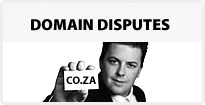South African Institute of Intellectual Property Law © 2024
www.saiipl.co.za | Privacy Policy

Domain Names - The High Court Has Its Say
Registry and registrar not liable for infringing domain names
A Brief Excursus on the South African Online Alternative Dispute Resolution
.za Alternative Dispute Resolution Regulations: The First Few SAIIPL Decisions
A study of the adjudication of celebrity domain name disputes (Neil Brown QC)
Sun International successful with suncityvacation.co.za domain name dispute.
MIXIT.CO.ZA: Dont get mixed up!
MXit wins mixit.co.za battle
The citroen.co.za Dispute is Decided (Tribute Site):
Is your business prepared for Domain Hijacking? by Cheryl L. Hodgson
Is your business prepared for Domain Hijacking? by Cheryl L. Hodgson
Domain Hijacking is Brandjacking!
Each week, nearly 3500 domains are hijacked from rightful owners. Your company could easily fall victim to brand and domain theft, which if left unchecked can serious impact the value of your trademark, as well as the bottom line value of your business. Brandjacking is one of the fastest growing crimes throughout the Internet.
One of our clients was recently the victim of brandjacking, leading us to send out
this advisory to assist others. Brandjacking is the unauthorized registration or
use of a trade mark in a domain for competitive purposes. Our client's site, which provided advertising and registration for seminars and work shops, was taken down, and her customers were being diverted to a "landing page" filled with competitive Pay-Per-Click ("PPC") ads. The new "owner" used a phony name, a non-existent address, and a third party's phone number, and was already making money from our client's domain.
Cybersquatting increased by 286%.
An April 2007 report issued by MarkMonitor® found that cybersquatting was up by 286% in 2006. The study analyzed twenty-five of the world's strongest brands over a four week period, finding more than 286,000 instances of cybersquatting, averaging 11,400 instances per brand! Not all instances require immediate action, but those that compete with or dilute a strong brand merit prompt attention.
What is "brandjacking?
In the broadest sense, "brandjacking occurs when a third party registers a domain name that infringes upon or otherwise violates the rights of a trademark owner."
It may take many different forms and creative ways to steal are discovered daily.
Several of the most flagrant abuses occur where:
1. A client fails to timely renew an expiring domain. An expiring domain can be
"snapped up" by computer software programs trolling for expired domains. While most registries offer a "grace period" to recover the domain, the fine print of the Registration Agreement may allow the registry to resell the domain without honoring the grace period. In our client's case, notices purportedly sent by the registry prior to expiration were never received by the administrative and technical contacts listed in the Whois data, leading us to question the reliability of renewal notices from domain registrars in the renewal process.
2. The registration is simply stolen. In these cases, the domain is illegally transferred without consent of the domain owner through deceptive means.
3. Domain Registry "Revenue Redirect" Landing Pages. Most clients now "pre-emptively" register variations of the main domain, such as .net or .org but do not establish use. We advise clients to forward "unused" domains to the main URL of the site since non-used domains are often "parked" by registrars with a landing page containing competitive goods and services, affectionately called "revenue redirect."
Check list for Preventing Brandjacking
Our client had wisely registered her underlying trademark prior to the hijacking,
enabling HLG to promptly file a Uniform Domain Dispute Proceeding (UDRP). A trade mark registration is required in order to bring a UDRP. The UDRP was created as a speedy, efficient alternative to costly litigation, and can be filed only with ICANN-approved arbitration centers, two of which include the World Intellectual Property Organization ("WIPO"), and the National Arbitration Forum.
The following check list will help insure your business is prepared:
* Register important trademarks, particularly those which rely upon one or more
domain names containing the "trademark," insuring the ability to act quickly should the need arise. Don't wait until it's too late.
* Consider a domain watch service from Thomson Compumark.
* Calendar renewal registered domains instead of relying solely upon renewal notices from domain registrars.
* Select automatic renewal options with reputable registrars, and consolidate all
domains with one reliable registrar.
* Keep separate administrative and technical contact information current for each domain.
* Update credit card information when they expire.
* Review the status of "preemptively" registered domains, such as .org, .net, etc. to make certain they have not been "parked." When registering domains, make certain to select options preventing the registrar from using this tactic.
In today's world a brand is more than the name of the product. It includes the domain names in which the brand or trademark is included, no matter what the variation. Remember, the most valuable asset of your business is likely to be your brand-or not.
© 2007 Cheryl L. Hodgson November 27, 2007 (chodgson@hodgson-law.com)
2007-12-09
